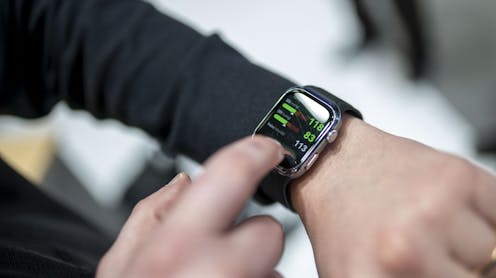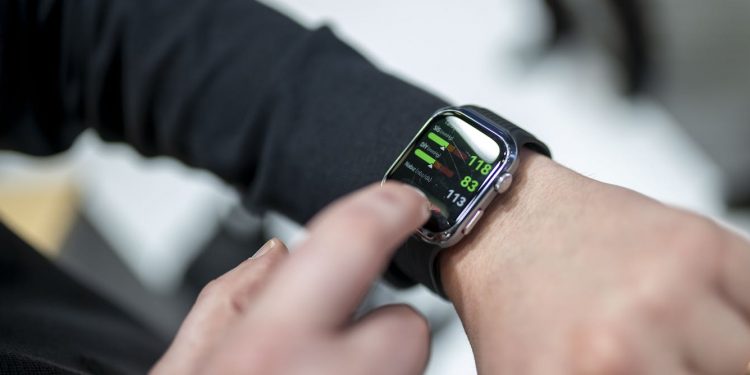
Smartwatches and other wearable devices can feel almost magical. Strap on a Fitbit, Apple Watch or Samsung Gear and you’re suddenly presented with a stream of data generated by – and about – your body: step counts, heart rate, blood oxygen level, calories burned and more.
Wearables offer tools that help people monitor and understand their bodies and, so the promise goes, improve their lives. Apple CEO Tim Cook has even said the technology company aspires to save your life.
As a professor who studies technology, I’ve spent the past decade researching smartwatches and other wearables. My new book, “Bringers of Order: Wearable Technologies and the Manufacturing of Everyday Life,” considers the gap between what these products promise and what they actually do.
Wearables rely on complicated sets of sensors and computer systems to create data for each user. As these devices become more common – and more complex – I worry that people may be tempted to think less about how they work. As a result, they might accept data at face value without considering how it was generated, whether it’s accurate, or even if it could put them at risk.
So to get the maximum value from wearable technologies, it’s worth reflecting on the differences between what these devices seem to do and what’s actually happening behind the screen. Here are a few key points to remember.
1. Steps aren’t really steps
Wearable fitness trackers gained popularity in the early 2010s for their ability to count steps and measure things such as distance, calories burned and flights of stairs climbed. While it’s tempting to think so-called step counts reflect the number of times a wearer’s feet have completed the action of taking a step, that is not the case.
In reality, a combination of sensors and algorithms work together to produce a data point called “a step.” In most instances, something called an accelerometer measures change in the wearable’s velocity. This is checked against an algorithm, which provides an automatic assessment of whether enough velocity has been reached to count as a step. These components measure how much the wearable moves, not the person. Shaking one’s wrist very quickly can sometimes create a “step,” while walking in place might not count steps.
2. Some skin tones don’t ‘work’ as well as others
Blood oxygen sensors have become incorporated into many smartwatches. They use a process called photoplethysmography, which uses tiny green LED lights on the underside of a smartwatch to track how blood flows through your wrist.
In 2022, a lawsuit alleged Apple was perpetuating racial bias, as its blood oxygen sensors didn’t work as well on darker skin. The case was dismissed, partly because these limitations of blood oxygen sensors have been known to researchers and medical practitioners for years. In other words, it is accepted that some features will not work as well for some people.
3. Your location may not be a secret
There’s an entire industry made up of people called data brokers who buy large datasets from technology companies and then sell them to advertisers, market analysts or other groups that may be interested in acquiring them.
While some companies have taken more steps to reduce or eliminate the sharing of data with third parties, and government agencies have offered strategies for users to limit location sharing, others may still share data among affiliates and service providers.
It’s important to check all settings for options to reduce or eliminate data sharing. Otherwise, your private information might not remain private for long. In 2018, for example, the exercise app Strava released a “heat map” showing the running and cycling routes of all its users through the location data it had collected – and accidentally disclosed the location of multiple secret military bases around the world.
4. Wearables for consumers aren’t medical grade
With wearables, as with other tech, it’s important to look carefully at the terms of use.
Most devices include boilerplate language about how the data they provide the wearer should be used recreationally and not replace formal diagnostics from doctors. Even though Apple has received FDA clearance for some of its health testing features and they may be quite useful for monitoring purposes, if you’re relying on data for health purposes, it’s important to consult a doctor.
5. Wearables can’t predict the future
OK, maybe this seems like it should be obvious. But it’s not.
Oura Ring, which pioneered measurements such as “restfulness” that try to measure how well you sleep, recently added a “symptom radar” to try to detect when you might be getting sick.
These technologies use sensors such as heart rate monitors and thermometers to detect changes in a wearer’s baseline. While these sickness forecasts may be helpful, they’re like weather reports for the body, detecting changes in the body’s internal atmosphere using available sensors and algorithms. Any claim to predict the future is based on looking for patterns in information from the past.
While wearable tech can offer powerful insights, understanding how devices work is crucial for making sense of the data they produce. A little skepticism goes a long way: It can challenge inflated promises and protect users. In the end, wearables are best understood as interesting but imperfect tools − not magic wands.
![]()
James Gilmore does not work for, consult, own shares in or receive funding from any company or organization that would benefit from this article, and has disclosed no relevant affiliations beyond their academic appointment.













